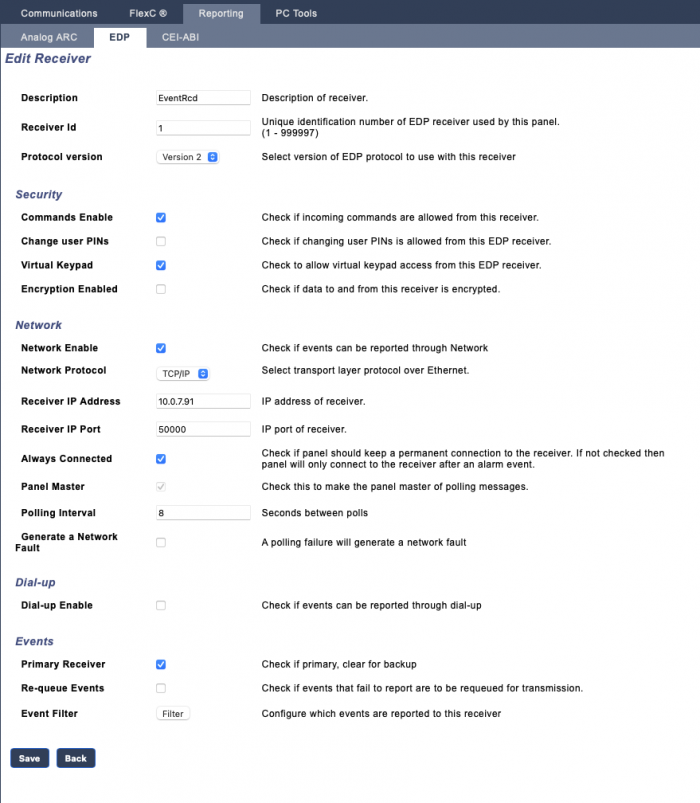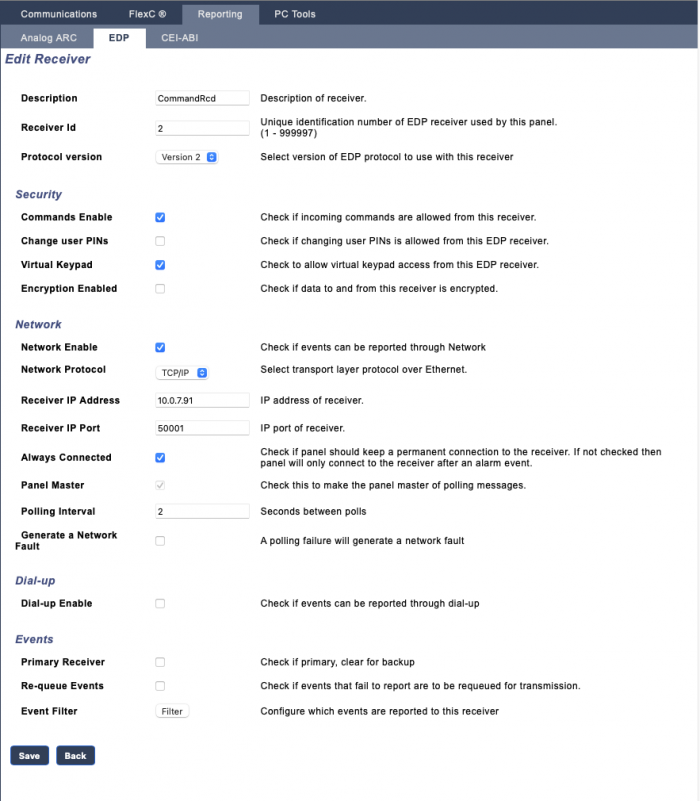Difference between revisions of "Siemens Vanderbilt Edp"
| Line 125: | Line 125: | ||
|<text> | |<text> | ||
|R | |R | ||
| − | |latest line of the security log when a new entry is added | + | |latest line of the security log when a new entry is added |
|- | |- | ||
Revision as of 14:38, 5 July 2022
Siemens / Vanderbilt is a family of security panels compatible with the control protocol EDP. This driver has been developed following the EDP protocol specification rev 2.2, 2012-11-12
The integration with HSYCO can be accomplished with a TCP/IP network connection.
Contents
Siemens / Vanderbilt Configuration
Login in the panel web configuration page using a Engineer account.
You should see something like this in the upper right corner of the web page:
Select "Configuration" then "Reporting" then "EDP". You must configure 2 different receivers, one for the command session, one for the event session.
Let's take a look in detail at the configuration of these receivers. The events receiver is configured as "Primary receiver".
Unflag "Primary receiver" for the command receiver. The "IP port" parameter must be different from the one of the event receiver. Set the "Receiver Id" to 1.
Flag "Always connected" on both the receivers. Select protocol version 2 on both. The "Receiver IP Address" is the IP address of the HSYCO server that you want to communicate with. Set the "Receiver Id" to 2.
The "Polling Time" is a very crucial parameter. In the event receiver configuration 8 seconds should be fine because every change of status is sent in asynchronous way by the panel and the polling time only represent the interval between one polling ack and the next one. In the command receiver configuration set 2 seconds, this time, by empirical methods, it's the best one to ensure the connection stability.
HSYCO Configuration
Add a SIEMENS EDP TCP I/O Server in the I/O Servers section of the Settings and set its parameters:
Communication
- IP Address: Leave empty
- IP Port: Leave empty
High Availability
- Shutdown when inactive: defaults to true.
Options
| ID | Default | Values | Description |
|---|---|---|---|
| eventsport | 50000 | number | the TCP/IP port specified in the event receiver of the panel |
| commandsport | 50001 | number | the TCP/IP port specified in the command receiver of the panel |
| eventsaddress | 1 | number | the event receiver id address |
| commandsaddress | 2 | number | the command receiver id address |
| startupevents | true | true | generate IO events also during the driver’s start-up phase |
| false | start generating events only after HSYCO is aligned with the current status of the system | ||
| gui | true | true | generate uisets |
| false | disable uisets | ||
| eventspolling | 8000 | number | the event receiver polling time in ms |
| commandspolling | 2000 | number | the command receiver polling time in ms |
Datapoints
| ID | Value | R/W | Description |
|---|---|---|---|
| connection | online | R | connection established |
| offline | R | connection failed | |
| log0 | <text> | R | latest line of the security log when a new entry is added |
| panel.firmware.type | <text> | R | firmware type of the panel |
| panel.firmware.version | <text> | R | firmware version of the panel |
| panel.hardware.version | <text> | R | hardware version of the panel |
| panel.serial.number | <text> | R | serial number of the panel |
| a<n>.armed | 1 | R | area is armed |
| 0 | R | area is disarmed | |
| a<n>.state | armed | R | area is armed |
| disarmed | R | area is disarmed | |
| inputsopen | R | area is in inputs open state | |
| trouble | R | area is in trouble state | |
| bypasserror | R | area is in bypass error state | |
| bypasswarning | R | area is in bypass warning state | |
| usercountnotzero | R | area is in user count not zero state | |
| exitdelay | R | area is in exit delay state | |
| entrydelay | R | area is in entry delay state | |
| disarmdelay | R | area is in disarm delay state | |
| codedelay | R | area is in code delay state | |
| a<n>.tamper.state | armed | R | area tamper is armed |
| disarmed | R | area tamper is disarmed | |
| busy | R | area tamper is busy | |
| a<n>.state.flags.alarm.activated | 1 | R | area alarm activated |
| 0 | R | area alarm is not active | |
| a<n>.state.flags.siren.activated | 1 | R | area siren activated |
| 0 | R | area siren is not active | |
| a<n>.state.flags.alarms.in.memory | 1 | R | at least one area alarm in memory |
| 0 | R | no area alarms in memory | |
| a<n>.state.flags.remote.armed | 1 | R | area remotely armed |
| 0 | R | alarm is not remotely armed | |
| a<n>.state.flags.force.armed | 1 | R | area forced armed |
| 0 | R | alarm is not forced armed | |
| a<n>.state.flags.instant.armed | 1 | R | area instant armed |
| 0 | R | alarm is not instant armed | |
| a<n>.state.flags.partial.armed | 1 | R | area partially armed |
| 0 | R | alarm is not partially armed | |
| a<n>.name[Note] | <text> | R | area name |
| o<n>.state | off | R | output is off |
| on | R | output is on | |
| onpulsed | R | output is in on pulsed state | |
| ontimed | R | output is in on timed state | |
| onpulsedtimed | R | output is in on pulsed timed state | |
| o<n>.ascii | <text> | R | output label in ascii format |
| o<n>.name[Note] | <text> | R | output name |
| i<n>.state | closed | R | input is closed |
| open | R | input in open | |
| short | R | input is in shortcut state | |
| tamper | R | input is in tamper state | |
| i<n>.closed | 1 | R | input is closed |
| 0 | R | input is open | |
| i<n>.short | 1 | R | input is in short status |
| 0 | R | input is not in short status | |
| i<n>.tamper | 1 | R | input is in tamper status |
| 0 | R | input is not in tamper status | |
| i<n>.ascii | <text> | R | input label in ascii format |
| i<n>.bypass.state.bypassed | 1 | R | input is bypassed |
| 0 | R | input is not bypassed | |
| i<n>.bypass.state.bypasslatched | 1 | R | input is bypass latched |
| 0 | R | input is not bypass latched | |
| i<n>.bypass.state.sirenlockout | 1 | R | input is siren lockout state |
| 0 | R | input is not in siren lockout state | |
| i<n>.name[Note] | <text> | R | input name |
| ti<n>.state | closed | R | trouble input is closed |
| open | R | trouble input in open | |
| short | R | trouble input is in shortcut state | |
| tamper | R | trouble input is in tamper state | |
| ti<n>.closed | 1 | R | trouble input is closed |
| 0 | R | trouble input is open | |
| ti<n>.short | 1 | R | trouble input is in short status |
| 0 | R | trouble input is not in short status | |
| ti<n>.tamper | 1 | R | trouble input is in tamper status |
| 0 | R | trouble input is not in tamper status | |
| ti<n>.ascii | <text> | R | trouble input label in ascii format |
| ti<n>.bypass.state.bypassed | 1 | R | trouble input is bypassed |
| 0 | R | trouble input is not bypassed | |
| ti<n>.bypass.state.bypasslatched | 1 | R | trouble input is bypass latched |
| 0 | R | trouble input is not bypass latched | |
| ti<n>.bypass.state.sirenlockout | 1 | R | trouble input is siren lockout state |
| 0 | R | trouble input is not in siren lockout state | |
| ti<n>.name[Note] | <text> | R | trouble input name |
| d<n>.lock.state | locked | R | door is locked |
| unlockedbyuseraccess | R | door is unlocked by user access | |
| unlockedbyschedule | R | door is unlocked by schedule | |
| unlockedbyusertimed | R | door is unlocked by user timed | |
| unlockedbyandlatched | R | door is unlocked by and latched | |
| unlockedbyrex | R | door is unlocked by rex | |
| unlockedbyren | R | door is unlocked by ren | |
| unlockedbykeypadmenu | R | door is unlocked by keypad menu | |
| unlockedbyarea | R | door is unlocked by area | |
| unlockedbyfirealarm | R | door is unlocked by fire alarm | |
| d<n>.locked | 1 | R | door is locked |
| 0 | R | door is unlocked | |
| d<n>.state | closed | R | door is closed |
| open | R | door is open | |
| openalert | R | door is open alert state | |
| leftopen | R | door is left open state | |
| forcedopen | R | door is forced open state | |
| d<n>.name[Note] | <text> | R | door name |
| a<n> | arm | W | arm area |
| armforce | W | arm area in force mode | |
| armstay | W | arm area in stay mode | |
| arminstant | W | arm area in instant mode | |
| disarm | W | disarm area | |
| disarm24h | W | disarm area | |
| disarmall | W | disarm all area | |
| o<n> | on | W | output on |
| off | W | output off | |
| ontimed-<seconds> | W | output on for a number of seconds equals to <seconds> E.G. o.ontimed-7, means on for 7 seconds. | |
| i<n> | removebypass | W | remove bypass input |
| tempbypass | W | temporary bypass input | |
| bypass | W | bypass for input | |
| ti<n> | removebypass | W | remove bypass trouble input |
| tempbypass | W | temporary bypass trouble input | |
| bypass | W | bypass for trouble input | |
| d<n> | lock | W | lock door |
| unlock | W | unlock door | |
| unlocklatched | W | unlock latched door | |
| v<n> | get | W | get the the value of the variable with index <n>. The value of variabile will be written in a datapoint v<n> = <value> |
| v<n> | value-<value> | W | set the the value of the variable with index <n>. |


